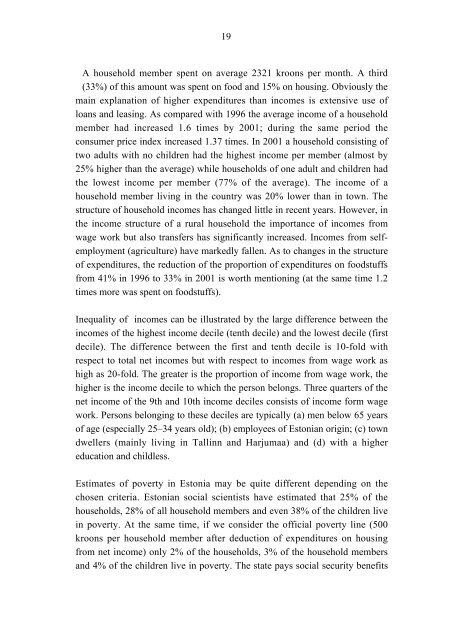Working Life Barometer in the Baltic Countries 2002 (pdf) - mol.fi
Working Life Barometer in the Baltic Countries 2002 (pdf) - mol.fi
Working Life Barometer in the Baltic Countries 2002 (pdf) - mol.fi
You also want an ePaper? Increase the reach of your titles
YUMPU automatically turns print PDFs into web optimized ePapers that Google loves.
19<br />
A household member spent on average 2321 kroons per month. A third<br />
(33%) of this amount was spent on food and 15% on hous<strong>in</strong>g. Obviously <strong>the</strong><br />
ma<strong>in</strong> explanation of higher expenditures than <strong>in</strong>comes is extensive use of<br />
loans and leas<strong>in</strong>g. As compared with 1996 <strong>the</strong> average <strong>in</strong>come of a household<br />
member had <strong>in</strong>creased 1.6 times by 2001; dur<strong>in</strong>g <strong>the</strong> same period <strong>the</strong><br />
consumer price <strong>in</strong>dex <strong>in</strong>creased 1.37 times. In 2001 a household consist<strong>in</strong>g of<br />
two adults with no children had <strong>the</strong> highest <strong>in</strong>come per member (almost by<br />
25% higher than <strong>the</strong> average) while households of one adult and children had<br />
<strong>the</strong> lowest <strong>in</strong>come per member (77% of <strong>the</strong> average). The <strong>in</strong>come of a<br />
household member liv<strong>in</strong>g <strong>in</strong> <strong>the</strong> country was 20% lower than <strong>in</strong> town. The<br />
structure of household <strong>in</strong>comes has changed little <strong>in</strong> recent years. However, <strong>in</strong><br />
<strong>the</strong> <strong>in</strong>come structure of a rural household <strong>the</strong> importance of <strong>in</strong>comes from<br />
wage work but also transfers has signi<strong>fi</strong>cantly <strong>in</strong>creased. Incomes from selfemployment<br />
(agriculture) have markedly fallen. As to changes <strong>in</strong> <strong>the</strong> structure<br />
of expenditures, <strong>the</strong> reduction of <strong>the</strong> proportion of expenditures on foodstuffs<br />
from 41% <strong>in</strong> 1996 to 33% <strong>in</strong> 2001 is worth mention<strong>in</strong>g (at <strong>the</strong> same time 1.2<br />
times more was spent on foodstuffs).<br />
Inequality of <strong>in</strong>comes can be illustrated by <strong>the</strong> large difference between <strong>the</strong><br />
<strong>in</strong>comes of <strong>the</strong> highest <strong>in</strong>come decile (tenth decile) and <strong>the</strong> lowest decile (<strong>fi</strong>rst<br />
decile). The difference between <strong>the</strong> <strong>fi</strong>rst and tenth decile is 10-fold with<br />
respect to total net <strong>in</strong>comes but with respect to <strong>in</strong>comes from wage work as<br />
high as 20-fold. The greater is <strong>the</strong> proportion of <strong>in</strong>come from wage work, <strong>the</strong><br />
higher is <strong>the</strong> <strong>in</strong>come decile to which <strong>the</strong> person belongs. Three quarters of <strong>the</strong><br />
net <strong>in</strong>come of <strong>the</strong> 9th and 10th <strong>in</strong>come deciles consists of <strong>in</strong>come form wage<br />
work. Persons belong<strong>in</strong>g to <strong>the</strong>se deciles are typically (a) men below 65 years<br />
of age (especially 25–34 years old); (b) employees of Estonian orig<strong>in</strong>; (c) town<br />
dwellers (ma<strong>in</strong>ly liv<strong>in</strong>g <strong>in</strong> Tall<strong>in</strong>n and Harjumaa) and (d) with a higher<br />
education and childless.<br />
Estimates of poverty <strong>in</strong> Estonia may be quite different depend<strong>in</strong>g on <strong>the</strong><br />
chosen criteria. Estonian social scientists have estimated that 25% of <strong>the</strong><br />
households, 28% of all household members and even 38% of <strong>the</strong> children live<br />
<strong>in</strong> poverty. At <strong>the</strong> same time, if we consider <strong>the</strong> of<strong>fi</strong>cial poverty l<strong>in</strong>e (500<br />
kroons per household member after deduction of expenditures on hous<strong>in</strong>g<br />
from net <strong>in</strong>come) only 2% of <strong>the</strong> households, 3% of <strong>the</strong> household members<br />
and 4% of <strong>the</strong> children live <strong>in</strong> poverty. The state pays social security bene<strong>fi</strong>ts

















